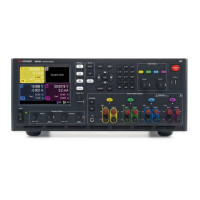Current Calibration
High Range Programming and Measurement
The output voltage may go negative at some point during this procedure on units that
have polarity reversal relays (Option 760).
Step 1. Connect a precision shunt resistor to the output. The shunt resistor should be able to measure
at least 120% of the output’s full-scale current (see Cal Setup B). Connect the Keysight 3458A DMM
across the shunt resistor.
Step 2. Select the full-scale current programming range. The value to program a range must be the
maximum current of the range. The following example selects the 3 A full-scale range of output 1.
Full-scale ranges vary according to model.
Front Panel Menu Reference SCPI Command
From the Calibration menu, select Current, High RangeProg and Meas. Then
select Start.
CAL:CURR 3, (@1)
Step 3. Select the first current calibration point and enter the data.
Front Panel Menu Reference SCPI Command
Display shows: “Enter P1 measured data” Calculate the shunt current (I=V/R)
and enter the data.
Press Selectwhen done.
CAL:LEV P1
*OPC?
CAL:DATA <data>
Step 4. Select the second current calibration point and enter the data.
Front Panel Menu Reference SCPI Command
Display shows: “Enter P2 measured data”
Calculate the shunt current (I=V/R) and enter the data. Press Selectwhen done.
Press Next to finish calibration.
CAL:LEV P2
*OPC?
CAL:DATA <data>
Low Range Current Measurement
Step 1. Connect only the current measurement terminals of the Keysight 3458A to the output
terminals (see Cal Setup D without the resistor).
Step 2. Select the low-current measurement range. The value to program a range must be the
maximum current of the range. This example selects the 100 mA range of output 1.
Front Panel Menu Reference SCPI Command
From the Calibration menu, select Current, Low RangeMeasurement. Then
select Start.
CAL:CURR:MEAS 0.15, (@1)
Step 3. Select the first current calibration point and enter the data.
8 Verification and Calibration
410 Keysight N6705C Operating and Service Guide

